To test this idea, the show MythBusters conducted an experiment. Host Adam Savage volunteered as the subject and lay under dripping water for several hours. He later described the sensation as “someone constantly pressing a finger” on his forehead—irritating, but far from unbearable.
Based on this, the show concluded that the “drip-drip-drip” itself didn’t cause much harm. The real stress, they found, came from being restrained for long periods. When they repeated the experiment on a relaxed subject without restraints, the effects were minimal.
While the MythBusters experiment offered some insight, the scientist in the video went further to explain why the blister theory doesn’t fully hold up. She pointed out that human skin is constantly shedding and regenerating, meaning the same spot isn’t exposed long enough to be damaged like stone. So realistically, a droplet wouldn’t be able to wear through the skin.
However, the story doesn’t end there. After the experiment, the MythBusters team received an anonymous email claiming they had missed an important detail—that in real-life accounts, the water droplets were often randomized. This randomness, the message said, created a constant sense of anticipation in the subject, which might be the true source of the psychological torture.


